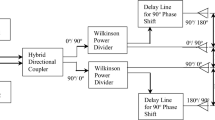Abstract
In order to mitigate the multipath propagation problems for high rate wlans such as Hiperlan (5 GHz) [2], we study an approach based on electronic beam steering over 360° in azimuth with the help of circular arrays of monopoles [3]. Design simplicity and size constraints intended for potential low-cost applications on the terminals has led us to favor a beam switching topology, using a single feeding-port [4]. Two competing configurations of the microstrip feeding circuit are presented and their principle of operation is experimentally validated through passive circuit configurations. The power distribution is achieved in the first one with the help of a pseudo-divider based on a modified 7-branch star junction, whose specific advantage is its very small size. Unfortunately, this design does not preserve the circular permutation invariance of the radiation patterns. The second circuit bypasses this problem in achieving a power distribution through a virtual point junction, at the cost of an appreciable increase in the circuit size.
Résumé
Afin de réduire les effets néfastes de la propagation multitrajets pour les réseaux locaux sans fil à haut débit de type Hiperlan (5 GHz) [2], une approche fon-dée sur le pointage électronique sur 360° d’azimut par des antennes sectorisées à base de réseaux circulaires de monopoles [3] est étudiée. Les contraintes de simplicité et d’encombrement imposées par les applications potentielles sur des terminaux à bas coûts conduisent à développer une topologie à commutation de diagramme, ne comportant qu’un seul accès d’alimentation. Deux configurations concurrentes du circuit d’excitation microbande sont présentées, et leur principe est validé expérimentalement dans des configurations passives. La répartition de puissance est obtenue dans le premier au moyen d’un pseudo-diviseur constitué d’une jonction à sept branches, dont le principal intérêt est la très faible dimension. Cependant, il ne préserve pas l’invariance par permutation circulaire des diagrammes de rayonnement. Le second circuit évite cet inconvénient en effectuant une répartition de puissance au moyen d’une jonction ponctuelle virtuelle, au prix de dimensions sensiblement plus importantes.
Similar content being viewed by others
References
Harrington (R. F.). Reactively controlled directive arrays.IEEE Trans. Antennas Propagation,26, 390, (1978).
Sibille (A.), Fassetta (S.), Roblin (C), Chelouah (A.). Beam steering circular arrays for wlans at 5 and 17 GHz.Journées Internationales de Nice sur les Antennes (JINA-98), Nice, pp. 354–357, (1998).
Sibille (A.), Roblin (C), Poncelet (G.). Beam steering circular monopole arrays for wireless applications.10th International Conference on Antennas and Propagation (ICAP’97), Edimburgh, pp., (Avril 1997).
Fassetta (S.), Sibille (A.), Roblin (C.). Circular antenna array fed by a seven-port star divider.Progress in Electromagnetic Research Symposium (PIERS-98), Nantes,1, pp. 148, (1998).
Kolundzija (B. M), Popovic (B. D.). Entire Galerkin method for analysis of metallic antennas and scatterers.Proc. IEE, Pt H,10, pp. 140,(1993).
Author information
Authors and Affiliations
Rights and permissions
About this article
Cite this article
Fassetta, S., Chelouah, A., Sibille, A. et al. Design of dedicated seven-port star dividers for sectored circular antenna array feeding. Ann. Télécommun. 54, 68–75 (1999). https://doi.org/10.1007/BF02998648
Received:
Issue Date:
DOI: https://doi.org/10.1007/BF02998648
Key words
- Antenna array
- Circular configuration
- Antenna feed
- Multipath propagation
- Monopole antenna
- Steerable beam antenna
- Power divider
- Star coupleur
- Circular sector
- Radiation pattern
- Input impedance




